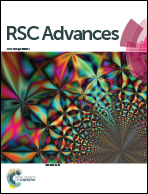Near-infrared asymmetrical heptamethine cyanines specifically imaging cancer cells by sensing their acidic lysosomal lumen†
Abstract
Tumor cytoreductive surgery faces great challenges to completely remove malignant residues due to the indistinct margin between the normal and neoplastic tissues. Intra-operative delineation of a tumor invasive margin will greatly improve the prognosis of the surgery. Near-infrared (NIR) fluorescence imaging shows advantages in delineating a tumor margin due to its high sensitivity and deep tissue penetration depth. Therefore, it is important to develop NIR fluorophores with high specificity and sensitivity. Cancer cells demonstrate more acidic lysosomal lumen (pH 3.8–4.7) than that of normal cells (pH 4.5–6.0), which facilitates their invasion, migration and metastasis. In this work, we developed five asymmetrical heptamethine cyanine (Hcyanine) based NIR fluorophores, in which a primary amine as a proton sensitizing group and another functional group as an electron density modulator were labeled on the Hcyanine respectively. While these fluorophores remained silent under a neutral environment, their fluorescence quantum yields increased 18–54 times upon the acidification from pH 7.4 to 2.4. Modulating the electron density on the fluorophores could fine tune their pKa (ΔpH = 0.1 pH units) to fit the lysosomal pH (pHlys) in cancer cells. AsP2 with a pKa of 4.0 visualized cancer cells, especially the invasive cancer cells with high selectivity. Even though AsP2 remained silent in the normal cells, its activation in the lysosomes after cytoplasmic acidification verified the feasibility to specifically detect tumor by distinguishing the pHlys discrepancy between the normal and cancer cells. Considering the up-regulated lysosomal acidity is a universal characteristic of cancer cells, pHlys responsive fluorophores are promising to accurately delineate tumor margin and guide intra-operative tumor resection with high sensitivity and universality.


 Please wait while we load your content...
Please wait while we load your content...